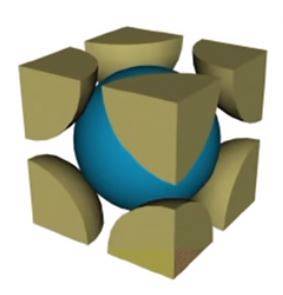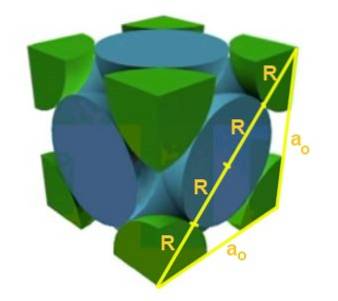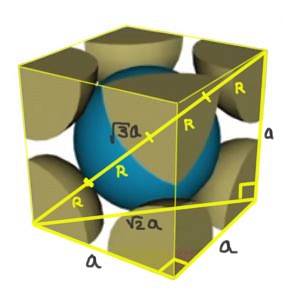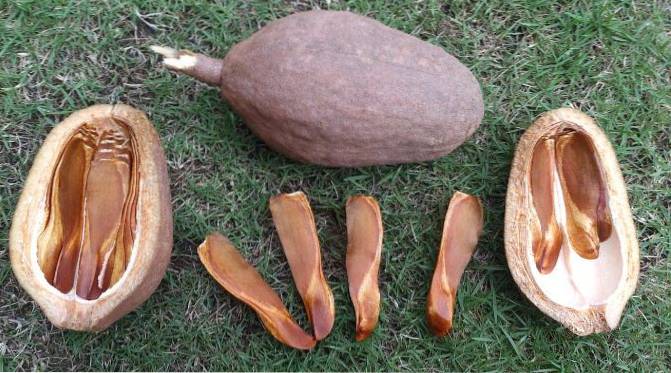
Bravais networks concept, characteristics, examples, exercises
The Bravais nets They are the set of fourteen three-dimensional unit cells in which the atoms of a crystal can be located. These cells consist of a three-dimensional arrangement of points that form a basic structure that is repeated periodically in the three spatial directions..
The origin of this denomination for the basic crystalline structures comes from 1850, when Auguste Bravais showed that there are only 14 possible three-dimensional basic unit cells.

The set of 14 Bravais networks are subdivided into seven groups or structures according to the geometry of the cells, these seven groups are:
1- Cubic
2- Tetragonal
3- Orthorhombic
4- Trigonal-Hexagonal
5- Monoclinic
6- Triclinic
7- Trigonal
Each of these structures define a unit cell, this being the smallest portion that preserves the geometric arrangement of the atoms in the crystal..
Article index
- 1 Characteristics of Bravais networks
- 1.1 Cubic networks
- 2 Examples
- 2.1 - Iron
- 2.2 - Copper
- 2.3 - Precious gems
- 2.4 Topaz
- 3 Solved exercises
- 3.1 Exercise 1
- 3.2 Exercise 2
- 3.3 Exercise 3
- 4 References
Characteristics of Bravais networks
The fourteen Bravais networks, as mentioned above, are subdivided into seven groups. But each of these groups has its unit cells with its characteristic parameters which are:
1- The network parameter (a, b, c)
2- Number of atoms per cell
3- Relationship between network parameter and atomic radius
4- Coordination number
5- Packing factor
6- interstitial spaces
7- By means of translations along the vectors a, b, c the crystal structure is repeated.
Cubic networks
It consists of the simple cubic or cubic network P, face-centered cubic network or cubic network F and the body-centered cubic network or cubic network I.
All cubic networks have all three network parameters corresponding to the x, y, z directions of the same value:
a = b = c
Cubic network P
It should be noted that atoms are represented by spheres whose centers are at the vertices of the cubic unit cell P.
In the case of the cubic lattice P the number of atoms per cell is 1, because at each vertex only one eighth of the atom is inside the unit cell, so 8 * ⅛ = 1.
The coordination number indicates the number of atoms that are close neighbors in the crystal lattice. In the case of the cubic lattice P the coordination number is 6.
Cubic network I
In this type of network, in addition to the atoms at the vertices of the cube, there is an atom in the center of the cube. So the number of atom per cell unit in cubic lattice P is 2 atoms.

Cubic network F
It is the cubic lattice that, in addition to the atoms in the vertices, has an atom in the center of the face of each cube. The number of atoms per cell is 4, since each of the six atoms of the face has half inside the cell, that is, 6 * ½ = 3 plus 8 * ⅛ = 1 at the vertices.

Hexagonal net
In this case, the unit cell is a straight prism with a hexagonal base. Hexagonal networks have all three network parameters corresponding fulfilling the following relationship:
a = b ≠ c
The angle between vector a and b being 120º, as shown in the figure. While between vectors a and c, as well as between b and c, right angles are formed.

The number of atoms per cell will be calculated as follows:
- In each of the 2 bases of the hexagonal prism there are 6 atoms at the six vertices. Each of these atoms occupies ⅙ of the unit cell.
- In the center of each of the 2 hexagonal bases there is 1 atom that occupies 1/2 unit cell.
- On the 6 side faces of the hexagonal prism there are 3 atoms each occupying ⅔ of the unit cell, and 3 atoms each occupying ⅓ of the unit cell volume.
(6 x ⅙) x 2 + ½ x 2 + ⅔ x 3 + ⅓ x 3 = 6
The relationship between the lattice parameters a and b with the atomic radius R under the assumption that all the atoms are of equal radius and are in contact is:
a / R = b / R = 2
Examples
Metals are the main examples of crystalline structures and also the simplest because they generally consist of only one type of atom. But there are other non-metallic compounds that also form crystalline structures, such as diamond, quartz, and many others..
- The iron
Iron has a single cubic unit cell with lattice or edge parameter a = 0.297 nm. In 1 mm there are 3.48 x 10 ^ 6 unit cells.
- Copper
It has a face-centered cubic crystalline structure, made up solely of copper atoms..
- Precious gems
Precious gems are crystalline structures of basically the same compound, but with small portions of impurities that are often responsible for their color..
Diamond
It is composed solely of carbon and does not contain impurities, which is why it is colorless. The diamond has cubic crystal structure (isometric-hexoctahedral) and is the hardest known material.
Quartz
It is composed of silica oxide, it is generally colorless or white. Its crystalline structure is trigonal-trapezohedral.
Ruby
It is composed of aluminum oxide with chromium impurities that give it its characteristic red color. Form a hexagonal crystal lattice.
Sapphire
It is also a crystal of aluminum oxide, but with impurities of titanium and iron, which are responsible for its blue color in various shades. Like the ruby has hexagonal structure.
Jade
Gemstone generally green in color, has monoclinic structure and is composed of iron-magnesium-calcium silicate.
Topaz
It is colorless with a orthorhombic structure aluminum fluoride-hydroxide-silicate.
Solved exercises
Exercise 1
Find the relationship between the lattice parameter and the atomic radius for a cubic lattice F.

Solution: First, it is assumed that the atoms are represented as spheres all of radius R in "contact" with each other, as shown in the figure. A right triangle is formed in which it is true that:
(4 R) ^ 2 = a ^ 2 + a ^ 2 = 2 a ^ 2
Therefore, the edge-radius relationship is:
a / R = 4 / √2
Exercise 2
Find the relationship between the lattice parameter and the atomic radius for a cubic lattice I (body-centered).

Solution: Atoms are supposed to be represented as spheres all of radius R in "contact" with each other, as shown in the figure.
Two right triangles are formed, one of hypotenuse √2a and the other of hypotenuse √3a as can be proved by using the Pythagorean theorem. Hence it follows that the relationship between the lattice parameter and the atomic radius for a cubic lattice I (centered in the body) is:
a / R = 4 / √3
Exercise 3
Find the packing factor F for a unit cell of a cubic structure F (face-centered cubic) in which the atoms have radius R and are in "contact".
Solution: The packing factor F is defined as the quotient between the volume occupied by the atoms in the unit cell and the volume of the cell:
F = Vatoms / Vcell
As demonstrated above, the number of atoms per unit cell in a face-centered cubic lattice is 4, so the packing factor will be:
F = 4 [4πR ^ 3/3] / [a ^ 3] =…
… 4 [4πR ^ 3/3] / [4R / √2] ^ 3 = (√2) π / 6 = 0.74
References
- Crystal Structures Academic Resource Center. [PDF]. Retrieved on May 24, 2018, from: web.iit.edu
- Crystals. Retrieved on May 26, 2018, from: thoughtco.com
- Pressbooks. 10.6 Lattice Structures in Crystalline Solids. Retrieved on May 26, 2018, from: opentextbc.ca
- Ming. (2015, June 30). Types Crystal Structures. Retrieved on May 26, 2018, from: crystalvisions-film.com
- Helmenstine, Anne Marie, Ph.D. (January 31, 2018). Types of
- Kittel Charles (2013) Solid State Physics, Condensed matter Physics (8th edition). Wiley.
- KHI. (2007). Crystalline Structures. Retrieved on May 26, 2018, from: folk.ntnu.no
- Wikipedia. Bravais lattices. Recovered from: en.wikipedia.com.



Yet No Comments